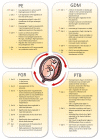Galectins: Important Regulators in Normal and Pathologic Pregnancies
- PMID: 36077508
- PMCID: PMC9456357
- DOI: 10.3390/ijms231710110
Galectins: Important Regulators in Normal and Pathologic Pregnancies
Abstract
Galectins (Gal) are characterized by their affinity for galactoside structures on glycoconjugates. This relationship is mediated by carbohydrate recognition domains, which are multifunctional regulators of basic cellular biological processes with high structural similarity among family members. They participate in both innate and adaptive immune responses, as well as in reproductive immunology. Recently, the discovery that galectins are highly expressed at the maternal-fetal interface has garnerd the interest of experts in human reproduction. Galectins are involved in a variety of functions such as maternal-fetal immune tolerance, angiogenesis, trophoblast invasion and placental development and are considered to be important mediators of successful embryo implantation and during pregnancy. Dysregulation of these galectins is associated with abnormal and pathological pregnancies (e.g., preeclampsia, gestational diabetes mellitus, fetal growth restriction, preterm birth). Our work reviews the regulatory mechanisms of galectins in normal and pathological pregnancies and has implications for clinicians in the prevention, diagnosis and treatment of pregnancy-related diseases.
Keywords: fetal growth restriction; galectin; gestational diabetes mellitus; maternal–fetal interface; pathologic pregnancy; preeclampsia; preterm birth.
Conflict of interest statement
The authors declare that they have no competing interest.
Figures



References
Publication types
MeSH terms
Substances
Grants and funding
LinkOut - more resources
Full Text Sources

